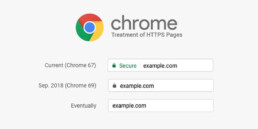
With the release of Chrome 69 comes the death of the "Secure" Indicator
The upcoming version of Google Chrome will focus on highlighting the negative security indicators instead of showing the well known ‘ Secure ’ label in the address bar.
Chrome 69, which will be available on September, will no longer display HTTPS sites as “Secure”. The reason is simple. Google wants the default state to be secure.
The tech giant announced earlier this year that the “Not Secure Label” will mark all the HTTP-only sites, starting from July. But it looks like the Chrome team will take things even further. Starting with October, the “Not Secure” indicator will flash red as soon as you start typing information on HTTP pages.
But what does “ Secure ” and “ Not Secure ” indicators mean to your website?
Well, starting with the Chrome 56, which has launched in January, Chrome has been in a continuous mission of cracking down websites that are not using encryption.
This is the reason why there are websites which have the “Not Secure” Label. Basically Chrome announces us that we might give our data (credit card info, passwords and so on) to a non-encrypted website.
Therefore, if you really want to gain credibility online from your customers, users and even Google, you may want to reconsider having a HTTP website. Make sure you get an SSL Certificate. This way your website will go from HTTP to HTTPS – this type of reassurance can boost your visibility and online credibility!
Protecting your Data
Online Security has always been a concern for these search engines. Therefore Google has been making major changes to Chrome with every new version. Their teams are working to help websites by forcing them to migrate to the more secure HTTPS protocol.
Our strong suggestion is to keep up with the new changes and migrate to HTTPS. We did so, and it helped a lot!
So, starting from September we’ll just have to get used to not seeing the positive green “Secure” label near the URL. There can be many reasons for websites not having HTTPS. Nobody wants their data on an non-encrypted website! However that does not mean they are all unsafe. Make sure you conduct research, maybe talk to someone that administrates the webpage before you give them your data. It only takes a few minute, but remember – Better Safe than Sorry!
SSL are no longer a burden. They’re fast, easy to implement and relatively cheap!
There are many SSL providers and it is up to you to choose one that suits your needs. However if you’re in need of providers, here are some of the Best
1. VeriSign
- considered to be one of the most trusted
- most expensive package: $1.000
- features: extended validation, $1.5 million warranty and vulnerability assessment
2. GeoTrust
- basic encryption cost: $149
- maximum security guaranteed: $299
3. Comodo
- business and personal use friendly
- basic package: $64.95
- extended validation package: $359
4. Digicert
- used by Microsoft, Yahoo, AT&T, Facebook, Amazon, Wikipedia, NASA and Core Logic
- Wildcard SSL Certificates (protect your entire domain): $500
5. Thawte
- cheapest plan: $149
- extended validation packages: less than $600
6. GoDaddy
- competent support 24/7
- standard package: $69.99
- deluxe package: $89.99
7. Network Solutions
- lowest prices for multi-year term
- four-year term: $49.99

Hi,Great, you loved our content.